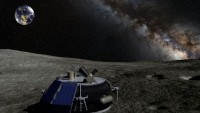China's Chang’e-5 to Land on the Ocean of Storms in late 2017
| Arthur Dominic Villasanta | | Jul 22, 2016 10:13 AM EDT |
Ocean of Storms (dark grey area)
China's Chang'e-5 surface sample return mission will land on the Moon's Ocean of Storms in the second half of 2017, revealed Wu Weiren, chief designer of China's Moon Exploration program.
This vast lunar mare on the western edge of the near side of the Moon is the resting place of the Soviet Union's Luna 9 and Luna 13 lunar probes, as well as Surveyor 1 and Surveyor 3 from the United States. Apollo 12, the second American manned spacecraft to land on the Moon, also touched down on the Ocean of Storms, otherwise known as Oceanus Procellarum.
Like Us on Facebook
Wu said the Ocean of Storms is a huge region and China wants to avoid having Chang'e-5 touch down on the landing spots of the Soviet and American spacecraft. He admitted China is looking for an "unprecedented landing site" for Chang'e-5 but wouldn't be more specific.
Chang'e-5 will blast-off from the Wenchang Satellite Launch Center on Hainan as the payload aboard a Chang Zheng 5 (Long March 5) launch vehicle. It will be China's first sample return mission to the Moon.
Once it touches down on the Ocean of Storms, the lander will dig and collect rock sample from up to two meters below the lunar surface. It will attempt to recover at least two kilograms of lunar soil and rock samples.
The lander will then lift-off and automatically rendezvous and dock with the return module in lunar orbit before returning to Earth.
China successfully landed Chang'e 3 on the Moon in December 2013, becoming only the third nation after the United States and Russia to land on the Moon.
The success of Chang'e-3 means its successor, Chang'e-4 (a lunar rover), is being reconfigured so it can undertake a more comprehensive mission. Chang'e-4 will become the first spacecraft to land on the dark side of the Moon. This historic feat is expected to take place in late 2018.
Chang'e-4 will land on the Aitken Basin to study geological conditions on the far side of the Moon.
TagsChang'e-5, Ocean of Storms, moon, Wu Weiren
©2015 Chinatopix All rights reserved. Do not reproduce without permission
EDITOR'S PICKS
-

Did the Trump administration just announce plans for a trade war with ‘hostile’ China and Russia?
-

US Senate passes Taiwan travel bill slammed by China
-

As Yan Sihong’s family grieves, here are other Chinese students who went missing abroad. Some have never been found
-

Beijing blasts Western critics who ‘smear China’ with the term sharp power
-

China Envoy Seeks to Defuse Tensions With U.S. as a Trade War Brews
-

Singapore's Deputy PM Provides Bitcoin Vote of Confidence Amid China's Blanket Bans
-

China warns investors over risks in overseas virtual currency trading
-

Chinese government most trustworthy: survey
-

Kashima Antlers On Course For Back-To-Back Titles
MOST POPULAR
LATEST NEWS
Zhou Yongkang: China's Former Security Chief Sentenced to Life in Prison

China's former Chief of the Ministry of Public Security, Zhou Yongkang, has been given a life sentence after he was found guilty of abusing his office, bribery and deliberately ... Full Article
TRENDING STORY

China Pork Prices Expected to Stabilize As The Supplies Recover

Elephone P9000 Smartphone is now on Sale on Amazon India

There's a Big Chance Cliffhangers Won't Still Be Resolved When Grey's Anatomy Season 13 Returns

Supreme Court Ruled on Samsung vs Apple Dispute for Patent Infringement

Microsoft Surface Pro 5 Rumors and Release Date: What is the Latest?













